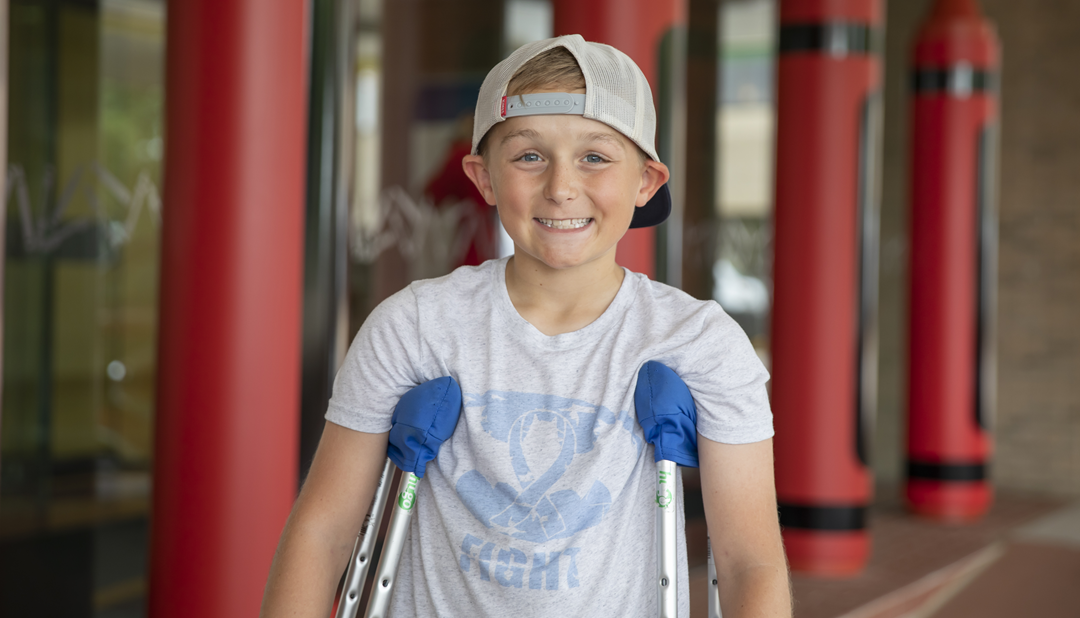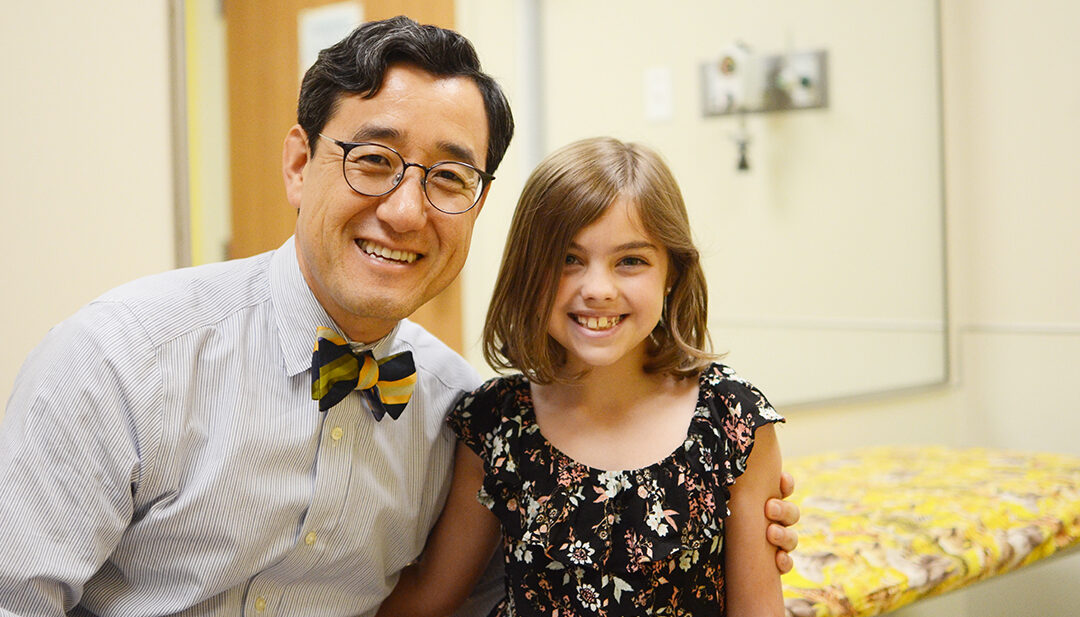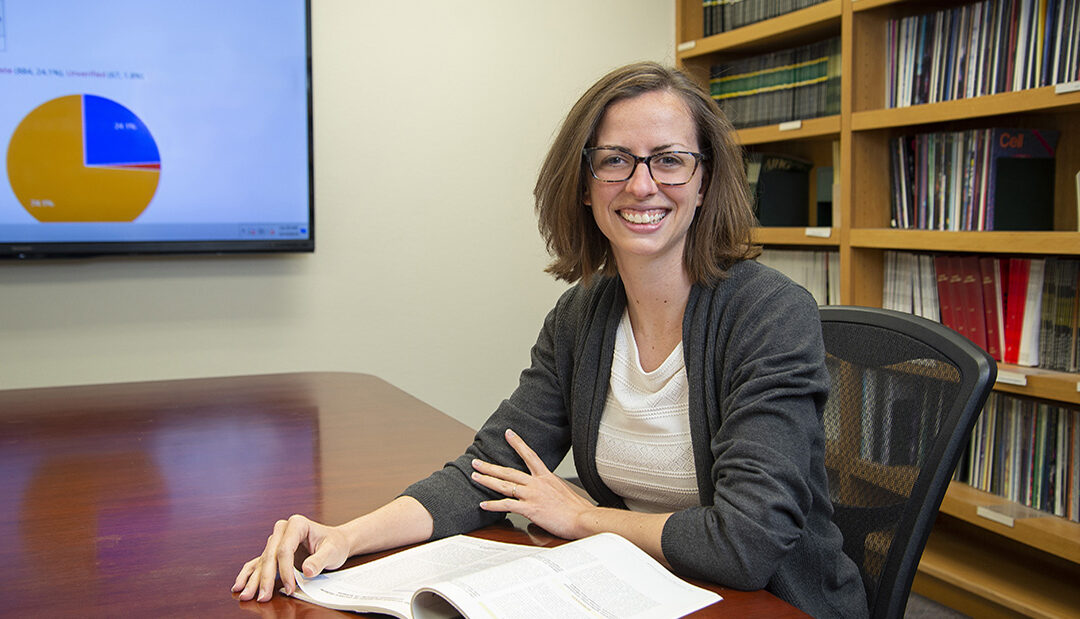
Brock’s Brigade – Fighting Perthes Step by Step
by Kristi Shewmaker
Kickball, wiffle ball, four square, taking hikes and riding bikes are a few of the activities 10-year old Brock, of Lee’s Summit, Missouri, enjoys. But, his first love is baseball.
“Baseball is his world,” his mother, Rachel, says. “He has played competitive baseball since he was 4.” In the spring of 2021, Brock played shortstop for a local team called the Baseknocks until midseason when he was diagnosed with Legg-Calvé-Perthes disease (Perthes), a rare childhood hip disorder, that temporarily took him out of the game and into a wheelchair.
Brock’s symptoms began with a pain in his groin. Then, he started to limp. “It was really bad,” Rachel says. “He couldn’t not limp.” She took Brock to visit his pediatrician who examined him but found nothing obvious like a broken bone. The doctor suggested trying physical therapy. “We thought maybe he had pulled a muscle,” Rachel says. After almost two months of physical therapy, Brock was still limping, and Rachel noticed that the thigh muscle in his right leg was two inches smaller than the thigh muscle in his left leg. “That was pretty alarming to me,” Rachel says. “I thought, ‘There’s something going on. It’s not just a pulled muscle.’” Later, an X-ray revealed that Brock had Perthes, a disease unknown to the family.
STEP 1: FINDING AN EXPERT
Perthes disease is a hip disorder that primarily affects the ball of the hip joint. The ball, or femoral head, is the upper part of the thighbone, or femur. The femoral head is normally round and fits inside the round socket of the pelvis. Perthes disease occurs when part or all of the femoral head loses blood supply. Without adequate blood flow, the femoral head bone dies. Over time, the body removes the dead bone and replaces it, initially, with softer bone. This bone is weaker, and the femoral head is more likely to collapse into a flattened position leading to deformity of the hip.
Perthes is rare, affecting approximately 15 children per 100,000 and is more common in boys than in girls, with a ratio of 5:1. The cause of Perthes is unknown, and currently, there is no cure. It typically occurs in children between 4 to 8 years old. Brock was diagnosed just before he turned 9.
“When you’re diagnosed with something that’s rare, and there’s not a ton of information, you feel like it’s a death sentence,” Rachel says. “I remember crying for the first three or four days because there were no answers, and no doctor could get us in. It was like a big, giant question mark.”
Rachel asked a friend, a physical therapist in nearby Kansas City, if she could recommend someone. Her friend said, “If it were my child, I would go see Dr. Kim at Scottish Rite.”
“Late at night, I sent a message to Scottish Rite and received a call the next day,” Rachel says. “Dr. Kim had an opening the day that we were going to be driving back through Dallas after a spring break trip to Galveston. It was clear that it was meant to be.”
STEP 2: GETTING EXEMPLARY CARE
A leading expert in Perthes disease, Harry Kim, M.D., M.S., is a pediatric orthopedic surgeon and director of the Center for Excellence in Hip at Scottish Rite for Children. Dr. Kim met with Brock and his family and confirmed the diagnosis.
“A perfusion MRI shows how much of the femoral head has blood flow,” Dr. Kim says. “Normally, it should be 100%. In Brock’s case, about 90% had no blood flow, which caused about 90% of his bone to die. His case was severe based on the amount of bone death and his age.”
Children ages 6 and younger tend to have better outcomes from Perthes disease because they have greater potential for developing new bone. Also, if half or more of the femoral head dies, the potential for regrowth without deformity is lower.
During the family’s initial visits, Dr. Kim and his team, including registered nurse Kristen Odom, explained the disease and Brock’s specific case and outlined the treatment options.
“When we came out of that first appointment, Brock said the best thing was that Dr. Kim looked at him, talked to him and asked him questions about how he was feeling, rather than just talking to me,” Rachel says. “It’s so important when you’re scared and uncertain, especially when you’re a kid, and the doctor makes you feel like you truly matter.”
After returning to Missouri, Rachel had more questions as the family processed the information. “Kristen spent an hour and 45 minutes on the phone with me,” Rachel says. “When I hung up, I told my husband we won’t ever go anywhere else. That kind of care simply doesn’t exist. When you’re dealing with a rare disease and your baby, that care is priceless.”
In May of 2021, Dr. Kim performed surgery on Brock’s right hip. “Brock presented with a mild collapse or deformity of the femoral head,” Dr. Kim says. “Without treatment, it would have degraded much further. We intervened before further collapse occurred.”
During the procedure, Dr. Kim cut the bone and positioned it so that he could tuck the femoral head securely into the hip socket. This containment procedure allowed the blood flow to come back naturally. He stabilized the bone with a metal implant that was removed in a later surgery. Over time, the body would remove the dead bone and generate new bone. To ensure healing, Dr. Kim prescribed a controlled weightbearing regimen, meaning Brock was unable to put any weight on his leg.
“He couldn’t play baseball, couldn’t run up the street to a friend’s house, couldn’t ride his bike,” Rachel says. “He went to school in a wheelchair, and kids stared at him and asked questions. We thought about ADA (Americans with Disabilities Act) accommodations everywhere we went. We had to rethink everything.”
STEP 3: FIGHTING FOR OTHERS
Despite all of these changes, Brock has taken it in stride. “He is my hero,” Rachel says. “Has he complained? Absolutely. Did he hate certain minutes, days and weeks? 100%. But overall, he was relieved to have an answer and a plan and no more pain. He has handled it better than I could have ever imagined.”
Last Christmas, Brock wanted to express his gratitude by designing and selling T-shirts as a fundraiser for Scottish Rite. “We called ourselves ‘Brock’s Brigade,’” Rachel says, “and put ‘His Fight Is My Fight’ on the front.” When the family traveled to Dallas for Brock’s second surgery in December, they presented a check for $1,000 to his care team. “Dr. Kim has really made an impression on Brock,” Rachel says. “This was Brock’s way of giving a little back so that hopefully it’s easier for kids in the future.”
“This family is so special,” Dr. Kim says. “They have gone through such difficulty, yet they want to help others improve their knowledge and support research. They are not just thinking about themselves but thinking about others.”
For more than a year, Brock completed a series of progressive exercises to restore muscle strength and range of motion. He went from using a wheelchair to bearing more and more weight on his crutches. In August, the answer the family had been holding their breath for finally came. Brock was given the all clear to walk.
“After we got the A-OK, Brock took his first walk with his dad and his brother,” Rachel says. “They do these “football walks” where his dad throws the football, and they go up ahead and catch it. They got to do that for the first time in a long time.”
Brock is especially excited for the day when he is cleared to play the sport he loves most. “Dr. Kim felt confident that Brock would be able to start winter practices and be 100% for spring baseball, which has been his goal from day one,” Rachel says. For now, Brock is easing back into his active life. He walks his dog, Pepper, and plays on the playground with his friends.
“The Scottish Rite team has been the biggest blessing to our family,” Rachel says. “Even being eight hours away and having to drive and fly multiple times throughout the last 18 months, I would drive four days to get to Scottish Rite. Our experience has been nothing short of amazing.”



